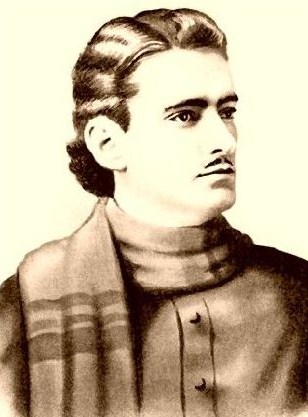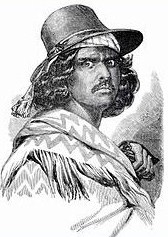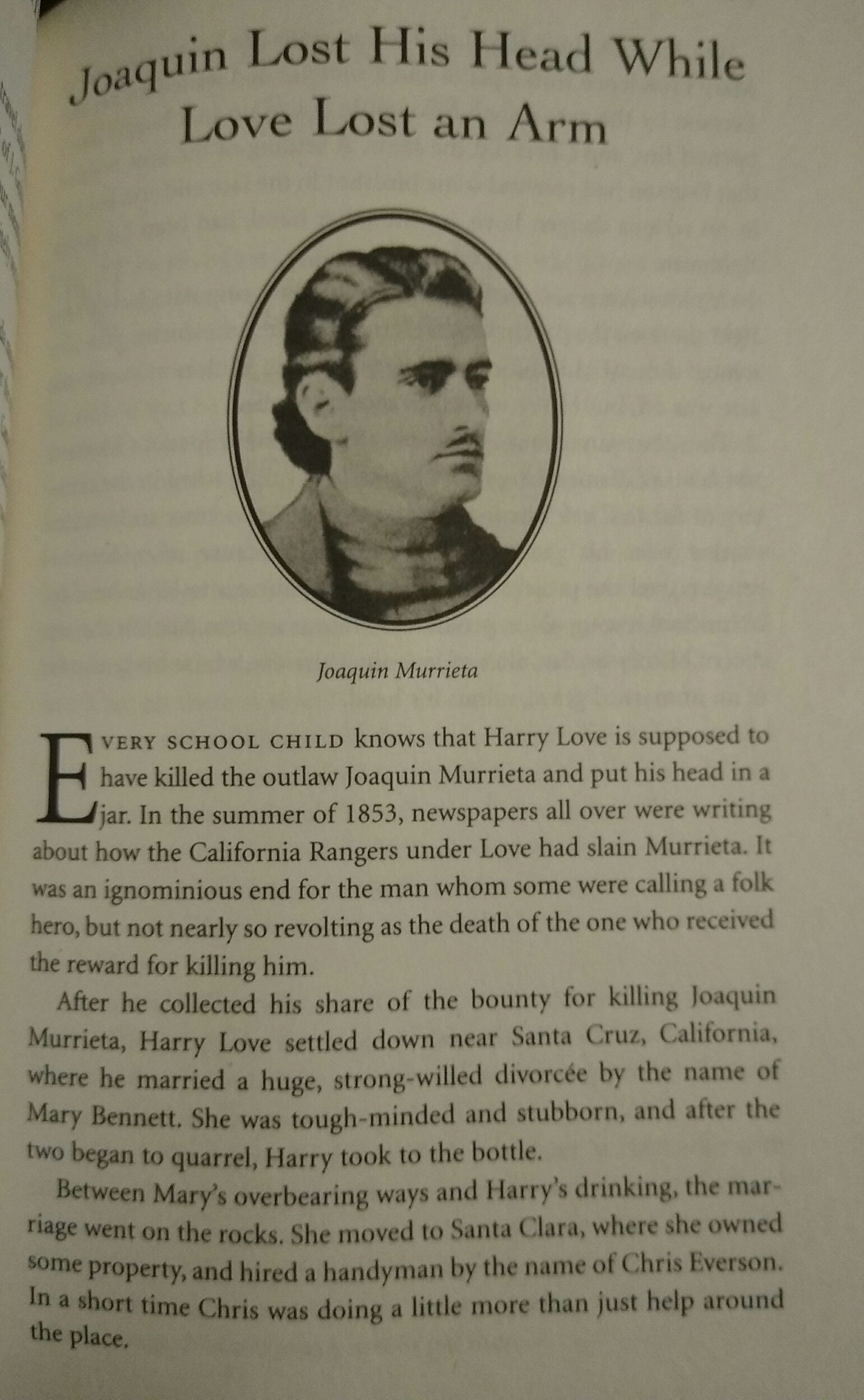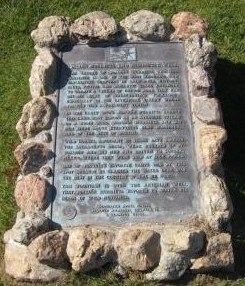Bitter dispute surrounds the figure of Joaquin Murrieta, who he was, what he did, and many of his life's events. This is well summarized by the words of historian Susan Lee Johnson:
"So many tales have grown up around Murrieta that it is hard to disentangle the fabulous from the factual. There seems to be a consensus that Anglos drove him from a rich mining claim, and that, in rapid succession, his wife was raped, his half-brother lynched, and Murrieta himself horse-whipped. He may have worked as a monte dealer for a time; then, according to whichever version one accepts, he became either a horse trader and occasional horse thief, or a bandit.
The place of Murrieta's birth is disputed. He was either born in Álamos in the northwestern state of Sonora, Mexico, or in Quillota, Chile (near Valparaiso).
The citing of his birthplace as allegedly being in Chile seems to be a result of reports that Murrieta sided with Chilean miners during the "Chilean War". A portion of Ridge's novel was reprinted in 1859 in the California Police Gazette. This story was subsequently translated into French, and the French version, with a Chilean Joaquín Murrieta, was translated into Spanish by Roberto Hynne, who claimed to have been in California during the gold rush.
Although Murrieta was considered to be Mexican and/or Chilean in biographical sources, there were a few reports that his mother's family were of Cherokee ancestry, a Native American people of part Anglo-Protestant origins. Her family came to either Mexico or, questionably, Chile from the Southeastern United States have quickly adapted European customs such as private land ownership and a farm plantation system; and married into the Murrieta family thus to Spanish land nobility. Many scholars dispute the Murrieta-Cherokee ancestral connection, although some Cherokees have settled in Mexico (esp. Texas) and other parts of Latin America during the 19th century.
Some alleged he went to California in 1849 to seek his fortune in the California Gold Rush. But instead of opportunity, he encountered racism and discrimination. While mining for gold, he and his wife supposedly were attacked by American miners jealous of his success. They allegedly beat him senseless, then raped his wife. However, the source for this series of tragic events is disputed as it was a dime novel written in 1854 (The Life and Adventures of Joaquin Murrieta by John Rollin Ridge). Historian Frank Latta, in his book Joaquín Murrieta and His Horse Gangs contended that the band was made up of family and friends, and that they regularly engaged in illegal horse trade with Mexico, after helping Joaquín kill at least six of his tormentors.
Historically, Murrieta was one of the so-called "Five Joaquins" listed on a bill passed in the California state legislature in May 1853, whereby a company of 20 rangers were hired for three months to hunt down Joaquin Botellier, Joaquin Carrillo, Joaquin Ocomorenia, Joaquin Muriata [sic] and Joaquin Valenzuela, and their banded associates.
On May 11, 1853, Governor of California John Bigler signed a legislative act creating the "California State Rangers", led by Captain Harry Love (a former Texas Ranger). The California Rangers were paid $150 a month and stood a chance to share the $1,000 governor's reward. On July 25, 1853, a group of Rangers encountered a band of armed Mexican men near Pacheco Pass in San Benito County, 50 miles (80 km) from Monterey. A confrontation took place, and two of the Mexicans were killed. One was claimed to be Murrieta, and the other was thought to be Manuel Garcia, also known as Three-Fingered Jack, one of Joaquin's most notorious associates. A plaque (California Historical Landmark #344) near the intersection of State Routes 33 and 198 now marks the approximate site of the encounter.
The Rangers severed Three-Fingered Jack's hand and the alleged Murrieta's head as proof of the outlaws' deaths, and preserved them in a jar of alcohol. The jar was displayed in Mariposa County, Stockton, and San Francisco, and later traveled throughout California; spectators could pay $1 to see them. Seventeen people, including a Catholic priest, signed affidavits identifying the head as Murrieta's, alias Carrillo, enabling Love and his Rangers accordingly received the reward money.
However, 25 years later, O. P. Stidger claimed that he heard Murrieta's sister say that the head was not her brother's. At around the same time, numerous sightings of old man Murrieta were reported. A few people claimed that Capt. Love failed to display the head at the mining camps, which was not true. It was even alleged by an anonymous Los Angeles based correspondent to the San Francisco Alta California Daily, in August 1853, that Love and his Rangers murdered some innocent Mexican mustang catcher and bribed people to swear out affidavits. The preserved head was destroyed in the 1906 San Francisco Earthquake.
Murrieta's nephew, known as Procopio, went on to become one of California's most notorious bandits of the 1860s and 1870s, and it was said that Procopio wanted to exceed the reputation of his uncle. Murrieta was partly the inspiration for the fictional character of Zorro. His name has, for some political activists, symbolized resistance against Anglo-American economic and cultural domination in California. The "Association of Descendants of Joaquin Murrieta" is devoted to putting forth that Murrieta was not a "gringo eater", but instead that "He wanted to retrieve the part of Mexico that was lost at that time in the Treaty of Guadalupe Hidalgo."
Bitter dispute surrounds the figure of Joaquin Murrieta, who he was, what he did, and many of his life's events. This is well summarized by the words of historian Susan Lee Johnson:
"So many tales have grown up around Murrieta that it is hard to disentangle the fabulous from the factual. There seems to be a consensus that Anglos drove him from a rich mining claim, and that, in rapid succession, his wife was raped, his half-brother lynched, and Murrieta himself horse-whipped. He may have worked as a monte dealer for a time; then, according to whichever version one accepts, he became either a horse trader and occasional horse thief, or a bandit.
The place of Murrieta's birth is disputed. He was either born in Álamos in the northwestern state of Sonora, Mexico, or in Quillota, Chile (near Valparaiso).
The citing of his birthplace as allegedly being in Chile seems to be a result of reports that Murrieta sided with Chilean miners during the "Chilean War". A portion of Ridge's novel was reprinted in 1859 in the California Police Gazette. This story was subsequently translated into French, and the French version, with a Chilean Joaquín Murrieta, was translated into Spanish by Roberto Hynne, who claimed to have been in California during the gold rush.
Although Murrieta was considered to be Mexican and/or Chilean in biographical sources, there were a few reports that his mother's family were of Cherokee ancestry, a Native American people of part Anglo-Protestant origins. Her family came to either Mexico or, questionably, Chile from the Southeastern United States have quickly adapted European customs such as private land ownership and a farm plantation system; and married into the Murrieta family thus to Spanish land nobility. Many scholars dispute the Murrieta-Cherokee ancestral connection, although some Cherokees have settled in Mexico (esp. Texas) and other parts of Latin America during the 19th century.
Some alleged he went to California in 1849 to seek his fortune in the California Gold Rush. But instead of opportunity, he encountered racism and discrimination. While mining for gold, he and his wife supposedly were attacked by American miners jealous of his success. They allegedly beat him senseless, then raped his wife. However, the source for this series of tragic events is disputed as it was a dime novel written in 1854 (The Life and Adventures of Joaquin Murrieta by John Rollin Ridge). Historian Frank Latta, in his book Joaquín Murrieta and His Horse Gangs contended that the band was made up of family and friends, and that they regularly engaged in illegal horse trade with Mexico, after helping Joaquín kill at least six of his tormentors.
Historically, Murrieta was one of the so-called "Five Joaquins" listed on a bill passed in the California state legislature in May 1853, whereby a company of 20 rangers were hired for three months to hunt down Joaquin Botellier, Joaquin Carrillo, Joaquin Ocomorenia, Joaquin Muriata [sic] and Joaquin Valenzuela, and their banded associates.
On May 11, 1853, Governor of California John Bigler signed a legislative act creating the "California State Rangers", led by Captain Harry Love (a former Texas Ranger). The California Rangers were paid $150 a month and stood a chance to share the $1,000 governor's reward. On July 25, 1853, a group of Rangers encountered a band of armed Mexican men near Pacheco Pass in San Benito County, 50 miles (80 km) from Monterey. A confrontation took place, and two of the Mexicans were killed. One was claimed to be Murrieta, and the other was thought to be Manuel Garcia, also known as Three-Fingered Jack, one of Joaquin's most notorious associates. A plaque (California Historical Landmark #344) near the intersection of State Routes 33 and 198 now marks the approximate site of the encounter.
The Rangers severed Three-Fingered Jack's hand and the alleged Murrieta's head as proof of the outlaws' deaths, and preserved them in a jar of alcohol. The jar was displayed in Mariposa County, Stockton, and San Francisco, and later traveled throughout California; spectators could pay $1 to see them. Seventeen people, including a Catholic priest, signed affidavits identifying the head as Murrieta's, alias Carrillo, enabling Love and his Rangers accordingly received the reward money.
However, 25 years later, O. P. Stidger claimed that he heard Murrieta's sister say that the head was not her brother's. At around the same time, numerous sightings of old man Murrieta were reported. A few people claimed that Capt. Love failed to display the head at the mining camps, which was not true. It was even alleged by an anonymous Los Angeles based correspondent to the San Francisco Alta California Daily, in August 1853, that Love and his Rangers murdered some innocent Mexican mustang catcher and bribed people to swear out affidavits. The preserved head was destroyed in the 1906 San Francisco Earthquake.
Murrieta's nephew, known as Procopio, went on to become one of California's most notorious bandits of the 1860s and 1870s, and it was said that Procopio wanted to exceed the reputation of his uncle. Murrieta was partly the inspiration for the fictional character of Zorro. His name has, for some political activists, symbolized resistance against Anglo-American economic and cultural domination in California. The "Association of Descendants of Joaquin Murrieta" is devoted to putting forth that Murrieta was not a "gringo eater", but instead that "He wanted to retrieve the part of Mexico that was lost at that time in the Treaty of Guadalupe Hidalgo."
Advertisement
Records on Ancestry
Sponsored by Ancestry
Advertisement







